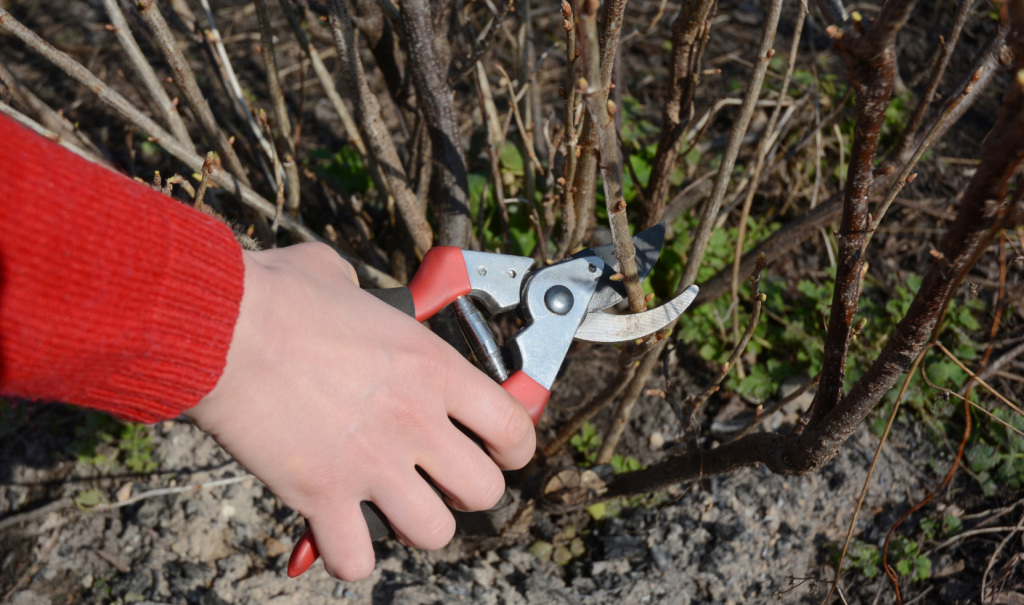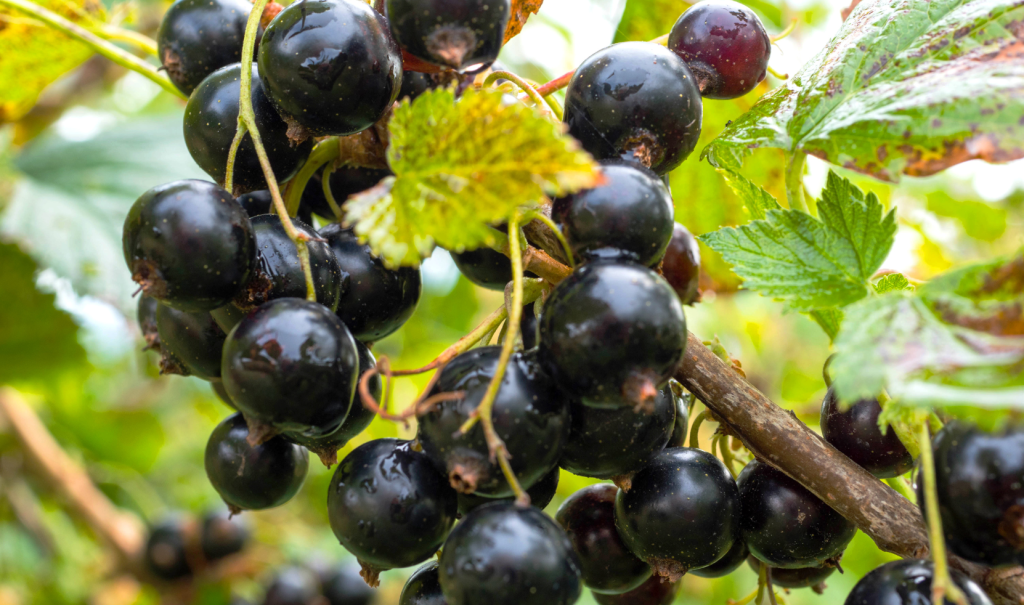Pruning blackcurrants is important to keep your plants in good health, as well as to encourage a lucrative harvest. In this guide, we’ll look at how to prune blackcurrants to ensure you get the most from your bushes.
Table of Contents
Introduction to Pruning Blackcurrants
When you prune blackcurrants, you are maximising your plant’s ability to provide a good crop each year. It is also key to ensuring that the plant itself is healthy. This article will detail the correct way to prune a blackcurrant bush in order to get the best crop out of your plants.
Tools Required for Pruning
And make sure you have the right tools: you’ll thank me later.
- Sharp Secateurs: Essential for clean cuts on smaller branches.
- Loppers: Useful for thicker branches, though not always necessary for blackcurrants.
- Gloves: Protect your hands from thorns and sharp edges.
- Disinfectant: Clean your tools before and after use to prevent disease spread.
Understanding the Goblet Shape
The shape of a goat’s head ensures the good air circulation and sunlight penetration A goat’s head is critical for the blackcurrant bushes. This structure of the bush will enable good air circulation and let sunlight in. If you prune away some excess growth that blocks the middle of the bush, it should maintain the original shape.
To achieve the goblet shape, focus on the following:
- Clear out the centre to prevent overcrowding.
- Remove crossing branches that can hinder growth.
- Encourage an open structure to allow light in.
Assessing the Health of Your Bush
Before pruning, assess the overall health of your blackcurrant bush. Look for signs of disease or damage, such as:
- Discolouration of leaves.
- Stunted growth or wilting.
- Presence of pests or signs of infestation.
If your bushes are healthy, the leaves will look good and the stems will be strong. You can potentially make your pruning more effective by looking for problems before you even start cutting.
Reducing the Size of the Bush
Unlike the other fruit bushes where you just need to cut back the height, with blackcurrants you are trying to reduce the spread of the bush, so cut off about a third of the whole bush.
To effectively reduce size:
- Identify older branches that are less productive.
- Cut back to the base to encourage fresh shoots.
- Avoid over-pruning; maintaining a balance is key.

Removing Old Growth for Renewal
Cutting off the old growth is necessary for your bush to continue to bear fruit. The older the branches, the less fruit they will produce, and they stop fresh shoots growing.
Follow these steps for effective renewal:
- Identify branches that are more than three years old.
- Cut them back to the base to promote new growth.
- Be mindful of the overall shape; maintain the goblet form.
If you concentrate on renewal, your bush will keep on producing for decades. You should try to replace some of the old branches every year to stay vigorous.
Best Practices for Pruning Blackcurrants
To achieve the best results when pruning blackcurrants, consider these best practices:
- Time your pruning in late winter or early spring before new growth begins.
- Make clean cuts at an angle to facilitate healing.
- Remove any weak or damaged branches, prioritising the health of the bush.
- Regularly monitor the bush throughout the growing season for any necessary adjustments.
Implementing these practices will not only improve the health of your blackcurrants but also enhance your overall gardening skills.
Identifying Crossing Branches
One of the major pruning tasks is eliminating any branches that cross. Crossing branches slow down the bush and make it vulnerable to disease, so they need to removed.
When inspecting your bush, look for branches that are:
- Intertwined and competing for space.
- Rubbing against each other, which can cause damage.
- Growing inward towards the centre of the bush.
You’ve cut those branches off so that the bush will get good airflow and sunlight through to its centre. Always cut back to an outward-facing bud – that encourages growth the right way.
Eliminating Weak and Old Growth
Along with crossing branches, weak and old growth also needs to be cleared out. Any weak growth tends to be less productive and can siphon energy away from fruitful areas of the bush. Old growth usually made up of branches that are three growing seasons or older.
Follow these steps to ensure effective removal:
- Identify branches that appear spindly or have minimal leaf coverage.
- Cut back old branches to the base to encourage the emergence of new shoots.
- Ensure that the remaining structure supports the goblet shape.
Consistently removing weak and old growth will rejuvenate your blackcurrant bush, promoting a more vigorous growth cycle.
Final Touches: Ensuring Upward Growth
Next, get rid of any crossing branches, as well as any very old growth. The rest of the branches should be allowed to grow upwards, which is necessary for blackcurrants to produce fruit, since they bear fruit on the last year’s growth.
To encourage this growth pattern:
- Trim back tips of branches to an outward-facing bud.
- Remove any branches that are growing horizontally or downwards.
- Monitor the bush for any new growth patterns throughout the season.
These final touches will help maintain the bush’s shape and productivity, setting the stage for a successful harvest.
Planning for Future Growth
However, pruning is not a once-off job: it’s part of a wider strategy to ensure the long-term health of your blackcurrants. Think about future growth as you prune.
Think about the following:
- Rotate your pruning focus each year to different sections of the bush.
- Monitor the growth patterns and adjust your pruning techniques accordingly.
- Plan to replace a third of the branches over three years to maintain vigour.
By planning for future growth, you ensure that your blackcurrants remain productive and healthy for years to come.
Key Takeaways for Pruning Blackcurrants
Pruning blackcurrants effectively can lead to a fruitful harvest. Here are the key takeaways:
- Focus on maintaining the goblet shape for optimal growth.
- Identify and remove crossing branches to enhance air flow.
- Eliminate weak and old growth to promote new shoots.
- Encourage upward growth to maximise fruit production.
- Plan for future growth by strategically rotating your pruning focus.
Implementing these strategies will not only improve the health of your bush but also enhance your overall gardening skills.
FAQ: Common Questions About Pruning Blackcurrants
You might have some questions as you set about pruning. Here are some key queries about blackcurrant pruning.
- When is the best time to prune blackcurrants? Late winter or early spring is ideal, just before new growth begins.
- How much should I prune? Aim to remove about a third of the branches, focusing on old and crossing branches.
- Can I prune blackcurrants in summer? It’s best to avoid summer pruning as it can reduce your harvest for that year.
- What tools do I need? Sharp secateurs are essential, and loppers may be useful for thicker branches.
- Will pruning affect my yield? Proper pruning can significantly enhance your yield by promoting healthier growth.
By addressing these common questions, you can approach pruning blackcurrants with confidence, ensuring a thriving harvest season.

